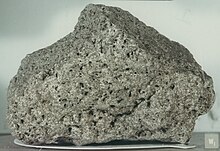Lunar basalt 70017


The Lunar basalt 70017 is a moon rock gathered in 1972 by astronauts Eugene Cernan and Harrison Schmitt on the Apollo 17 mission near their Apollo lunar lander from the valley of Taurus-Littrow on the moon and divided into 1.1 gram pieces.
History
Lunar basalt 70017 is a moon basalt that was last collected by astronauts Eugene Cernan and Harrison Schmitt on the last manned moon landing, Apollo 17. After gathering the basalt rock from the surface of the moon the two astronauts made a speech referring to "the children of the world". They wished that parts of the rock be given out to various institutions around the world as a goodwill gesture. In 1973 President Nixon gifted 1.1 gram pieces of the lunar basalt 70017 that were encased in a small Lucite ball and mounted on a wooden plaque display. They were given worldwide to all countries and all 50 United States and its provinces. Some countries were not even aware they were given the Apollo displays. Some of the displays with the moon rocks have been stolen, while others have been lost in inventory. NASA still has about 80 percent of the original rock.[1][2][3]
Description
The Apollo 17 Lunar Sample Information Catalog, 1973, describes it as a "holocrystalline, equigranular basalt containing some poikilitic plagioclase". Its total weight before being broken up was 2957 grams. The sliced off 1.1 gram moon chip segments from lunar basalt 70017 consists of 30 percent plagioclase, 59 percent pyroxene, 10 percent ilmenite and 1 percent olivine. The Apollo 17 "Lunar basalt 70017" is described by technicians as a coarse-grained high-Ti basalt. It has been described as moon soil with a crystallization age around 3.7 billion years and an exposure age of about 220 million years. All surfaces of the blocky angular shaped stone are rough and jagged.[4]
References
- ^ Office of Inspector General (December 8, 2001). "NASA'S MANAGEMENT OF MOON ROCKS AND OTHER ASTROMATERIALS LOANED FOR RESEARCH, EDUCATION, AND PUBLIC DISPLAY / Goodwill Moon Rocks and Ambassador of Exploration Awards" (PDF). Retrieved November 3, 2012.
{{cite journal}}: Cite journal requires|journal=(help) - ^ "Where are the moon rocks?". The Rock Collector. Biscuit Software Ltd. 2004.
- ^ Earth magazine, March 2011, pp. 42-51
- ^ Lunar basalt 70017 - Ilmenite Basalt
Further reading
- Kloc, Joe (February 19, 2012). The Case of the Missing Moon Rocks. The Atavist/Amazon Digital Services, Inc. p. 47. ASIN B007BGZNZ8.
External links
- Pearlman, Robert (1999–2012). "Where today are the Apollo 11 goodwill lunar sample displays?". collectspace.com. Retrieved November 2, 2012.
- Pearlman, Robert (1999–2012). "Where today are the Apollo 17 goodwill lunar sample displays". collectspace.com. Retrieved November 2, 2012.
- Video of the "Goodwill rock" gathered from the moon
- Apollo program lunar sample displays
- Apollo program
- Lunar science
- Petrology
- United States–European relations
- United States–Central American relations
- United States–South American relations
- United States–African relations
- United States–Asian relations
- United States–Caribbean relations
- United States–Middle Eastern relations
- United States–North American relations
- United States–Oceanian relations
- Lunar samples

